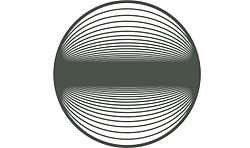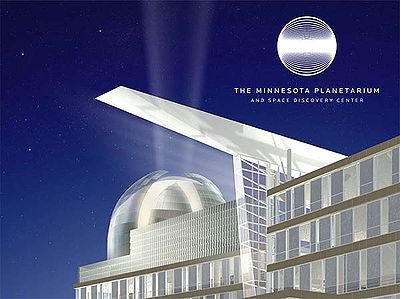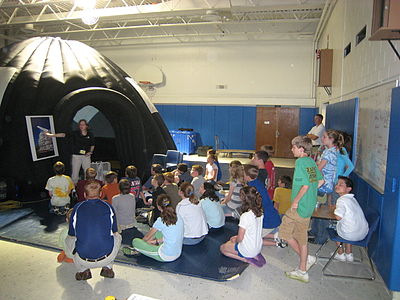- Minnesota Planetarium
-
Coordinates: 44°58′48″N 93°16′12″W / 44.980134°N 93.270085°W
Minnesota Planetarium Society 
Established 2003 Location Minneapolis, Minnesota Type Planetarium Director Angus Vaughan Website http://www.minnesotaplanetarium.org The Minnesota Planetarium Society (MNPS) is a Minneapolis, Minnesota, landmark, located inside the Minneapolis Public Library. The Society currently isn't open to the public, and public shows are not available on a daily basis.
Contents
History
In 1889 the Minnesota Academy of Science was granted space in the Minneapolis Public Library for a science museum. When the Academy disbanded in 1929, the Library assumed responsibility for the science museum in a partnership that has evolved and endured for almost 80 years.
In 1950, the City of Minneapolis built a new central downtown library and, to honor its partnership with science, a planetarium was included within it, the only library outside of Alexandria, Egypt, to contain such a feature. 170,000 visitors came to see the night skies during the early years after opening. From 1974 to 1982, the Minneapolis Library had an agreement with the Science Museum of Minnesota to jointly run the planetarium. The Friends of the Minneapolis Public Library agreed to take over its funding and management in 1982. The Minneapolis Planetarium was shuttered when the central library was torn down in 2002 to make way for the new Cesar Pelli-designed facility that would be funded largely through a city referendum. Plans called for a new planetarium with surrounding exhibit space to be built as the library’s fifth and sixth floors. Financing for construction of this project was to come through bonds authorized by the State of Minnesota. When this strategy was initially determined, it seemed quite likely to gain State support as it was a statewide resource: From the opening to the closing of the old planetarium, over 4 million Minnesota visitors took advantaged of the facility and its star-shows programs. Even in its last years, with no new capital investment or equipment since its inception, no marketing and no formal school contracts, the planetarium thrilled 70,000 visitors per year.
When the Minneapolis Public Library was torn down in 2002, the former planetarium was shuttered with the understanding that it would be rebuilt as part of the new library.
ExploraDome
To provide programming to a state without a public planetarium, the Minnesota Planetarium Society in the fall of 2006 purchase purchased a revolutionary combination of technology providing sensational new views of the known universe as previously only displayed in large planetariums such as the Hayden Planetarium in New York City. The system utilizes innovative software, Uniview, and was designed by Swedish academics at Linköping University along with scientists at the American Museum of Natural History. The software digitally contains all the known imagery in the universe. Now visitors are not bound by earth with only a view of the stars, as in old planetariums, they can travel anywhere in space, fly through the Orion nebula to witness the birth of new stars, or visit billions of galaxies in the vast regions of space. Looking back from space, visitors see Earth as never before, watching the changes on its surface from yesterday or from billions of years ago. This immersive imagery is possible because of a revolutionary fish-eye-lens projection system developed by Elumenati Inc. With Uniview, a visitor steps into a 3D world where huge leaps of time and space can be taken—all proportioned to a small convex space. The space? An inflatable, mini, portable planetarium fabricated in Minnesota especially for Uniview. This dome seats 25-35 visitors, can be collapsed and transported (easily fitting into the back of a minivan) and sets up relative quickly in a school gymnasium or other similar expansive indoor space. The Minnesota Planetarium Society, realizing the power of this technology combination, was the first organization in the world to purchase the package. It named the dome “The ExploraDome” and the program it was to field “the ExploraDome Immersive Learning Program.”
Funding
2002: The Minnesota Legislature agreed to Phase 1 funding for the Minnesota Planetarium and Space Discovery Center at the level of $9.5 million. Governor Jessie Ventura vetoed over 300 million dollars for capital bonding projects - including $9.5 million for the Planetarium.
2004: The Minnesota Planetarium Society submitted a $24.1 million funding request for a Minnesota Planetarium & Space Discovery Center to be built in the new Minneapolis Public Library building. The planetarium didn't make it onto Governor Tim Pawlenty's list of capital bonding projects.
2005: The Minnesota Legislature granted $22 million in funding via a bonding bill. The new Planetarium was intended to be built on the 5th floor of the new Minneapolis Public Library building.
2011: During the July 2011 special "Government Shutdown" session of the Minnesota Legislature, the bonding authorization of $22 million for the Minnesota Planetarium was cancelled. During the 2011 legislative session, the House Capital Investment Committee looked closely to de-fund projects bonded in previous years, but had yet to start construction. The intent was to free up money for projects that are ready to go. [Public Information Services 1] In this bill, several projects were marked for defunding, including the Minnesota Planetarium, which was approved at $22 million in 2005. On the morning of July 14, 2011, Governor Mark Dayton announced that he would reluctantly sign the budget proposed by the Republican legislative leadership.
2011 astrological comments
Parke Kunkle, a Minneapolis Community and Technical College professor and MnPS board member was interviewed by the Star Tribune. The interview disturbed cherished assumptions about astrology: many people assumed that they had been born under a particular sun sign, associated with their birthday according to a table dating back to the time of Claudius Ptolemy. Kunkle has published a new table, corrected for the precession of the Earth's orbit, which changes the signs of most people. For example, a person born in early July would be a Gemini, not a Cancer.
References
- ^ Public Information Services, Minnesota House of Representatives. "Higher education benefits from bonding bill". Session Daily. Public Information Services. http://www.house.leg.state.mn.us/hinfo/sessiondaily.asp?storyid=2846. Retrieved 31 July 2011.
Categories:- Planetaria in the United States
- Buildings and structures in Minneapolis, Minnesota
Wikimedia Foundation. 2010.


